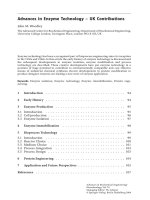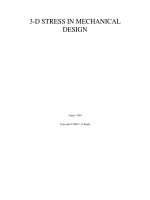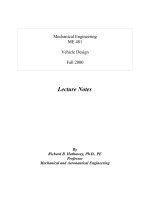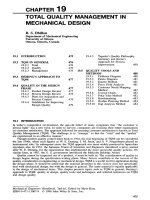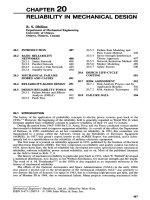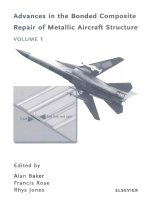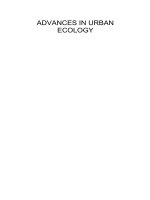Advances in vehicle design ( TQL )
Bạn đang xem bản rút gọn của tài liệu. Xem và tải ngay bản đầy đủ của tài liệu tại đây (14.81 MB, 187 trang )
Advances in Vehicle Design
To Ruth
Advances in Vehicle Design
by
John Fenton
Professional
Engineering
Publishing
Professional Engineering Publishing Limited
London and Bury St Edmunds, UK
First published 1999
This publication is copyright under the Berne Convention and the International
Copyright Convention. All rights reserved. Apart from any fair dealing for the
purpose of private study, research, criticism, or review, as permitted under the
Copyright Designs and Patents Act 1988, no part may be reproduced, stored in
a retrieval system, or transmitted in any form or by any means, electronic,
electrical, chemical, mechanical, photocopying, recording or otherwise, without
the prior permission of the copyright owners. Unlicensed multiple copying of this
publication is illegal. Inquiries should be addressed to: The Publishing Editor,
Mechanical Engineering Publications Limited, Northgate Avenue, Bury St
Edmunds, Suffolk, IP32 6B W, UK.
© John Fenton
ISBN 1 86058 181 1
A CIP catalogue record for this book is available from the British Library.
The publishers are not responsible for any statement made in this publication.
Data, discussion, and conclusions developed by the Author are for information
only and are not intended for use without independent substantiating investigation on the part of the potential users. Opinions expressed are those of the
Author and are not necessarily those of the Institution of Mechanical
Engineers or its publishers.
Printed and bound in Great Britain by St Edmundsbury Press Limted,
Suffolk, UK
CONTENTS
vii Preface
Chapter 1: Materials and construction advances
2 Steel durability and structural efficiency
3 Vigorous development of light alloys
4 Hybrid metal/plastic systems
7 Recycled PET, and prime PBT, for sun-roof parts
10 Material property charts and performance indices
13 Design for self-pierce riveting
Chapter 2: Structure and safety
20
24
27
31
Structure analysis for interior noise
Preparing for statutory pedestrian protection
Design for the disabled
Adaptive restraint technologies
Chapter 3: Powertrain/chassis systems
36
45
47
52
58
62
Powertrains: the next stage?
Constant-pressure cycle: the future for diesels?
Valve arrangements for enhanced engine efficiency
Trends in transmission design
The mechanics of roll-over
Suspension and steering linkage analysis
Chapter 4: Electrical and electronic systems
70
76
79
81
84
90
Automotive electronics maturity
Navigation system advances
Digital circuits for computation
Proprietary control system advances
Hybrid drive prospects
Automation of handling tests
Chapter 5: Vehicle development
96 Mercedes A-class
102 Ford Focus
108 Land Rover Freelander
112 Project Thrust SSC
Chapter 6: Systems development: powertrain/chassis
118 Engine developments
122 Engine induction systems
124 Refinement and reduced emissions
128 Drive and steer systems
133 Suspension development
139 Braking systems
Chapter 7: System developments: body structure/systems
144 Structural systems
144 Controlled collapse
145 Body shell integrity
147 Chassis/body shell elements
151 Car body systems
151 Occupant restraint
155 Doors, windows and panels
159 Trim and fittings
161 Aerodynamics and weight saving
163 CV systems
163 CV chassis-cab configuration
164 Cab/body fittings
168 Advanced bus/ambulance design
173 References
175 Index
Preface
This lite'rature survey is aimed at providing the vehicle design engineer with an
update in vehicle and body systems. The author has scanned the considerable
output of technical presentations during 1997- 9 to extract and distil developing
technologies of particular import to the working designer. The easily digestible
presentation, with unusually high dependence on diagrammatic presentation,
continues the popular style used for the original handbooks that were compiled
by the author, and published by Professional Engineering Publishing. These are
listed on the Related Titles page overleaf. Advances in Vehicle Design serves both
as an update to the earlier volumes and as a stand-alone volume. The referenced
leads provided in the text are intended to help designers and engineers from
whatever background discipline. Widespread availability of computing power to
designers and engineers has created the possibility of considerably shortening the
lead-times between design conception and prototype manufacture. Much of the
material covered here will assist in establishing predictive techniques.
Advances in Vehicle Design is an update of vehicle and body systems design
in that it provides readers with an insight into analytical methods given in a wide
variety of published sources such as; technical journals, conference papers, and
proceedings of engineering institutions, for which a comprehensive list of references is provided. The analyses are therefore not necessarily fully developed or
rigorously evaluated. Recourse to the original references is necessary particularly
in order to understand the limiting assumptions on which the analyses are based.
Much of the analytical work is centred around impending legislation and, where
this is quoted in the text, it is for illustration only and it is, of course, important to
examine the latest statutes in the locality concerned. The list of references given
at the end of the volume is a key element of the publication, providing where
possible a link to the original publication source. Where the original publication is
not available in bookshops, many of the sources can be found in libraries such as
those of the Institution of Mechanical Engineers, London, or the Motor Industry
Research Association, in Nuneaton, UK,as well as the BritishLibrary.Othersimilar
respositories of techincal information should be able to provide a selection of
original source material. Where the source is a company announcement of
techniques and systems, names, but not addresses, of the companies/consultancies are given. Most operate internationally and have different national locations,
best found by enquiry in the country concerned. For the patent reviews in chapters
six and seven, full specifications can be purchased from The Patent Office, Cardiff
Road, Newport, NP91RH, UK.
JOHNFENTON
Related Titles
Title
Editor/Author
Multi-Body Dynamics
HRahnejat
Gasoline Engine Analysis
J Fenton
Handbook of Automotive Body Construction
J Fenton
and Design Analysis
Cranes - Design, Practice and Maintenance
J Verschoof
Handbook of Automotive Body Systems Design J Fenton
Handbook of Automotive Powertrain and
J Fenton
Chassis Design
Vehicle Handling Dynamics
J Ellis
Handbook of Vehicle Design Analysis
J Fenton
Automotive Braking: - Recent Developments
D Barton
Brakes and Friction Materials
G A Harper
Automotive Engineer Monthly Magazine
W Kimberley
Journal of Automotive Engineering (IMechE Proceedings Part D)
ISBN/ISSN
1 80058 122 6
0 85298 634 3
1 86058 073 4
1 86058 130 7
1 86058 067 X
1 86058 075 0
0 85298 885 0
0 85298 963 6
1 86058 131 5
1860581277
0307/6490
0954/4070
For full details of all Professional Engineering Publications please contact:
Sales Department
Professional Engineering Publishing
Nothgate Avenue
Bury St Edmunds
IP326BW
UK
Telephone: +44 (0)1284 763 277
Fax:
+44(0)1284718693
E-mail:
Chapter 1:
Materials and construction advances
The considerable comeback made by the steel industry in
restating its case for structural superiority over the light alloys,
and the ever moving goalposts of developing aluminium and
polymer composites, open this chapter. The re-emergence of
hybrid metal/plastic structures is also discussed as well as the
creation of reinforced plastics with recycled-polymer matrices.
The move to material property charts which lead to the
creation of performance indices is next examined and the
chapter concludes with the efforts to make self-pierce riveting
a viable alternative to conventional welded joints in body
construction.
VEHICLE DESIGN
Steel durability
and structural efficiency
According to researchers at Lotus Engineering1, market expectations for durability of vehicle body panels
is typically seven years or 100 000 miles, with an
expectation of 10 years corrosion-free life. British
Steel engineers2 have shown the main influences on
durability with the corrosion triangle of Fig 1. In
product design the traditional approach has been to
remove moisture traps, allow better penetration of
paint and evolve design with greater resistance to
stone chipping. There had also been gradual adoption
of one-side zinc-coated steel panels, offering protection on the inside and good paintability on the outside. More recently there had been a move from hot
dip galvanized to electrozinc panels, spurred by
Japanese manufacturers; these offer a range of
ductilities, increased weldability and the ability to
alloy the coating to provide various coating thicknesses and corrosion resistance levels. Now doublesided coated steels are favoured with differential
coating weights: typical thicknesses are now 45-60
g/m2. Future quality improvements are promised by
development work in surface treatment and
formability. Permanent organic based topcoats or
phosphate coatings are providing improved performance in both weldability and corrosion prevention.
Another new initiative is a drive by the OEMs to
replace electroplated products by 'galvanneal' ones
for outside parts, in the interests of production
economy. These have the ability to provide good
paintability.
In a joint venture between British Steel Strip
Products and Rover Group, trial parts were prepared
for the Rover 600, including front fender, front door
skin, rear door skin and bonnet. In 1997 all new
models were produced with two-sided galvanneal
full-finished panels. In the longer term, the authors
see the development of non-bake hardening, higher
strength steel substrates with enhanced formability
for use with galvanneal coatings, and the introduction of extra high strength transformation induced
plasticity (TRIP) steels as substrates for zinc type
coating which will offer yield strength approaching
1500 MPa, alongside high ductility. Prepainted body
finished sheet steel, which obviate the electropheritic
primer coat are also expected, as is a possible new
coating process based on vapour deposition of zinc in
a vacuum.
Car body weight reduction of 25%, without
cost penalty, plus a 20% reduction in part count, has
been the result of the final phase of the USLAB
project for light-weighting steel automotive structures carried out by an international consortium of
steel companies supervised by Porsche Engineering
Services. The objective of a feasible design, using
commercially available materials and manufacturing processes, has also been met. An 80% gain in
torsional rigidity, and 52% in bending, has also been
recorded and estimated body-shell cost of $947 compares with $980 for a year 2000 comparison figure for
Environment
(including micro environment)
Autobody
Materials of
Construction
Fig 1: Triangle of factors affecting corrosion
Fig 2: ULSAB body shell
Fig 3: Monoside panel
Fig 4 : Side roof rail
Design
MATERIALS AND CONSTRUCTION
a conventionally constructed body to a similar specification. The 203 kg body shell (Fig 2), of 2.7 metres
wheelbase, has a torsional rigidity of 20,800 Nm/deg
and a first torsional vibration mode of 60 Hz, using
the well-documented construction techniques.
A supercomputer analysis of crashworthiness
has shown that frontal NCAP and rear movingbarrier levels have been achieved at 17% higher than
the required speed. The body has also satisfied 55
kph/50% offset AMS, European side impact and roof
crush requirements. The 35 mph frontal NCAP showed
a peak deceleration of 31 g, considered satisfactory in
that stiffer body sides are required to meet 50% AMS
offset requirements. The offset AMS frontal impact
deceleration showed a peak at 35g, considered a good
result in relation to the severity of the test. The
simulation was carried out at 1350 kg kerb weight,
plus 113 kg luggage and 149 kg for two occupants. At
the final count, high strength steel was used for 90%
of the structure, ranging from 210 to 550 MPa yield,
in gauges from 0.65 to 2 mm. Around 45% of the
structure involved laser-welded tailored blanks, including the monoside panels, Fig 3, which ranged in
gauge from 0.7 to 1.7 mm and was made up of steel
elements having yield strengths from 210 to 350
MPa. Fig 4 shows the hydroformed side roof rail.
To the casual observer the elements of the
complete body shell 'look' more structurally efficient but they still seem a far cry from a fully
optimized shape for the steel 'backbone', as much of
the material seems to be still used in relatively low
stress areas where its function is as a 'cover' rather
than a fully working structural element. Perhaps the
next stage in weight reduction should be in designing
a highly efficient steel monocoque, then moulding
over plastic elements for the non-structural covering
and closure shaping details, using the hybrid metal/
plastics techniques discussed later in this chapter.
Fig 5 A12 concept
car and structure
Vigorous
development of light alloys
Phase 2 of Audi's aluminium alloy body construction
programme was unveiled at a recent Motor Show in
the form of the A12 concept car, Fig 5. The 3.76 metre
long times 1.56 metre high car weighs just 750 kg in
1.2 litre engined form, some 250 kg less than a
conventional steel body vehicle, it was argued. The
number of cast nodes has been reduced compared
with the Phase-one aluminium alloy structure of the
Audi A8. Most of the nodes are now produced by
butt-welding the extruded sections. High level seating is provided over a sandwich-construction floor.
Use of internal high pressure reshaping techniques
has reduced the number of shaping and cutting operations required
The 1997 International Magnesium Association Design Award for applications went to the diecast instrument panel support beam, Fig 6, on the GM
G-van. It is a one-piece design weighing, at 12.2 kg,
5.9 kg less than the welded steel tubular structure it
replaced. Proponents of magnesium alloy are pointing out that as die-castings in the material solidify
from the outside in, they enjoy a dense chilled skin
together with a relatively course-grained interior.
Skin thickness is said to be relatively constant regardless of total wall thickness so that reductions in
section size can often be made when the material is
used as a substitute. The AZ91D (9% aluminium, 1%
zinc) alloy is now finding application in removable
rear seats for minivans. In the seat systems shown in
Fig 7, Delphi Automotive have achieved 60% weight
reduction over conventional construction by adopting a cast magnesium cushion frame and an extruded
VEHICLE DESIGN
aluminium back frame. Other magnesium grades are
being used in combination with engineering plastics
for composite instrument panels. VW have also
demonstrated a Polo door in pressure die-cast magnesium with a carbon fibre reinforced outer panel,
which offers over 40% weight reduction over conventional steel construction.
Hybrid metal/plastic systems
Metal/plastic composites have been promoted again
by Bayer in a recent presentation to body engineers3.
A compelling argument is made for using simplified
thin-wall structures in high strength metals which are
stabilized by plastic composites which can also cut
down on welding operations when combined as an inmould assembly. The complexity of CV-cab and car
bodies has often ruled against the effective use of
lightweight metal systems on their own.
In the latest version of the technique, the processes of inserting, where metal parts such as bushes
are included in a polymer moulding, and/or outserting
where various functions in plastic are moulded on to
a metal baseplate, are taken a stage further. Crosssectional distortion of thin-walled metal beams can
be prevented by relatively small forces applied in the
new process by the presence of moulded plastic
supports in the form of x-pattern ribbing.
The deformation behaviour of various section
profiles under bending and torsion is shown in Fig 8
a and b. Interconnecting points between plastic and
metal are preformed in the metal part before it enters
the plastics mould. Either corrosion-protected steel
or aluminium alloy is the normal choice of metal with
glass-fibre reinforced, impact modified, polyamide6 (Bayer's Durethan BKV) being the plastic choice.
Bayer say it is not always desirable to have the metal
'preform' in one piece, separate sections being joined
by moulding resin around the prefabricated inter-
Fig 9: Front end structure in hybrid metal/plastic
Fig 10: Metal/plastic hybrid door structure
Fig 6 : Instrument panel beam
Fig 7: Mg and Al used in seat frame
MATERIALS AND CONSTRUCTION
reduction in component and investment cost, for the
same performance capability. Car front-ends with
integrated bumper systems are further good candidates, Fig 9. A research project has also been carried
out on car side doors having sufficient structural
integrity to transmit impact forces from A- to B-post
in the closed position. Fig 10 shows a sample door,
requiring no further framework to support wing
mirror, lock or other door 'furniture'. Seat frames
with integral belt-anchorages have also been made
locking points or by means of clinching integrated
into the mould. It is said that for recycling purposes,
it takes only a few seconds to break a metal/plastic
composite, using a hammer mill, and that the resin
element has properties akin to the virgin material, on
reuse.
Sample applications include instrument panel
supports. In the cross-car beam co-developed by
GM's Delphi a 40% reduction in weight was obtained
against the replaced assembly, along with a 10%
0
2
Fig 8a: Deformation behaviour
40
10
12
14
Deformation
18
20
Nm
30
25
20
15
10
5
0
0
2
Fig 8b: Behaviour in twist
6
8
10
Twisting
12
18
VEHICLE DESIGN
for the Mercedes-Benz Viano minibus in the process.
The first volume car to incorporate the technology is
the Audi A6. The front-end design was developed in
association with the French ECIA company. The part
is injection moulded in one piece and incorporates
engine mountings, together with support for radiator
and headlights.
Bayer have also been active in a joint-venture
glazing project with GE Plastics. A $40 million
development programme is under way on abrasionresistant, coated polycarbonate vehicle windows as
an alternative to glass systems. An abrasion-resistance equal to that of glass is targeted and highvolume production of windows is foreseen. Some
40% weight saving is forecast against equivalent
glass systems and greater design freedom plus higher
impact resistance is also claimed. Better resistance to
forced entry, and reduced injuries in side-impact and
roll-over accidents, have also been mooted.
Structural design
in polymer composites
Work reported from Delphi Interior and Lighting4 has Fig 13: Audi A6 sun-roof
shown the possibility of constructing instrument
panel crossbeam and display panel assemblies in
injection-moulded plastics. The structural crossbeam
provides both structural integrity, to the assembly,
and an air passage for the primary air vents; it
attaches to the A-pillars at each of its ends and
operates as a simply supported beam. In one concept
by the company, Fig 11, the beam supports the
display panel but is not integral with it. In the second
concept, Fig 12, the panel and beam form an integral
structure. The advantage of this second concept is the
allowance of further integration of components into
the single total assembly.
Both concepts were built for retrofitting into a
current production vehicle so that proper in-service
evaluation could be obtained. In the CAD analysis Fig 14: Sun-roof with Venetian blind
DEFROSTER DUCT
Fig 11: Plastic structural beam
MATERIALS AND CONSTRUCTION
the initial objective was to develop a design for the
plastic structures that would provide static stiffness
equivalent to that of the baseline steel structure. The
first natural frequency of the beam was also matched
to the steel baseline. Both objectives were met without resort to wall thicknesses that would have compromised conventional injection-mould cycle times.
The next requirement was to meet FMVSS
impact energy absorption levels resulting from input
loads to the knee bolsters supported by the system in
a 30 mph crash. It was found that materials with strain
rates as low as 2% could absorb this energy without
overload to the occupant's femur. Finally the structure had to meet these performance levels under
specified temperature and vibrational environments,
necessitating an evaluation of creep and fatigue
capability. Temperature range of-30 to +190 F and
fatigue criteria were based on subjection to service
loads measured under real road conditions.
Recycled PET, and prime PBT,
for sun-roof parts
Following the recent interest shown in Chrysler's
plan for using low-cost, glass-reinforced polyethylene
terephthalate (PET) for its China car body construction, comes an announcement from DuPont that it is
supplying recycled PET for corner mouldings of the
Webasto sun-roof of the Audi A6, Fig 13. The
mouldings hold the sliding roof frame's aluminium
rails together and incorporate guides for the cable
that moves the roof and channels off rain-water. The
material has withstood 30,000 open-close cycles in
trials of the sun-roof. In another sun-roof application,
DuPont's polybutylene terephthalate (PBT) resin by
Westmont Technik of Dusseldorf is used in a new
design of sliding roof incorporating a built-in Venetian
blind, Fig 14. The PBT slats of the blind can be
adjusted to deflect cooling air into the vehicle in hot
weather. The company has also introduced a PBT
grade, Crastin 5000, for electrical connectors and
parts.
This has improved hydrolysis resistance for
Retention of properties USCAR/EWCAP Class 3
Temperature/Humidity Testing
high temperature and high humidity operation. The
Standard Crastin- Standard Crastin. Competitive first variants produced, for connectors, have 30%
15%GRPBT HR5015F 30%GRPBT HR5030F HR PBT glass reinforcement and properties are seen in the
(30% Glass)
Tensile strength, Mpa
table, left.
Initial
109
74
114
145
99
Further details have also been released on the
After 40 cycles*
57
75
90
104
106
Retention, %
52
101
62
105
93
Chrysler China car which is now called the ComposElongation, %
ite Concept Vehicle. Its shell structure is made up of
Initial
3.0
3.5
2.8
3.3
3.3
four major elements, Fig 15, to fit over a steel chassis.
After 40 cycles"
1.5
2.9
2.2
1,3
2.8
Retention, %
50
83
Target cost of the PET-based GRP is less than £2 per
50
67
79
0
kg,
compared with £6.50 - £8.50 for SMC and SRIM.
" Each cycle consists of 6 hr. at 90 C/95% Rh followed by 2 Hr. at 125'C with humidity vented
DEFROSTER DUCT
JOINED SURFACES
S4WDEFOGGER
STRUCTURAL I.P. DUCT
Fig 12: Plastic structural instrument panel
VEHICLE DESIGN
When the four shell elements are bonded together enough torsional stiffness is available without
the need for further reinforcement. Ashland Pliogrip
fast-cure adhesive is used and cycle time for making
the four main mouldings is three minutes, seven
minutes faster than for equivalent sized SRIM mouldings. The low cycle time has been achieved by a
sequence of gate openings and gas injections into the
mould to help guide the process, which was devised
using computer-aided mould-flow techniques. An
8500 tonne machine injects the PET resins into the
145 tonne moulds, which each measure a massive 4.5
X 2.5 X 2 metres.
fibre has been developed by applying the theory of
multilayered thin-film interference to a cross section
of the fibre. This is the principle behind the iridescent
scales of Morpho butterfly wings. The fibre displays
a high metallic sheen and a clear colour shade under
exposure to different types of light, including natural,
fluorescent and incandescent. The colour properties
and tint also vary depending on the light source used
and the viewing angle. As the fibre does not use any
dyes, the production of the fibre reduces environmental pollution due to waste dye solutions. It also
prevents any worries about skin rashes or other
allergic reactions to dyes.
Structural-coloured
fibre has body trim potential
Nissan has announced the development of what is
claimed to be the world's first structural-coloured
fibre, in a joint venture with Teijin Limited and
Tanaka Kikinzoku KK, Fig 16. The colour of the
fibre is produced by its structure and does not involve
the use of dyes. The principles of this technology are
based on research into biometrics, an engineering
practice that looks at prominent functions of living
things and applies them in practical applications.
One of the findings of this research is the principle
behind the iridescence of the wings of Morpho butterflies native to South America. Research has been
conducted to apply this knowledge to the production
of coloured fibres for interior and exterior trim materials, including seat fabric. The structural-coloured
Fig 15: Composite Concept Vehicle shell
2.0
Structural-colored filament
1.0
Fig 16: a: right,
Reflective spectra of
some samples; b,
opposite, the
technology explained
0.4
0.5
0.6
Wavelength (um)
MATERIALS AND CONSTRUCTION
10
VEHICLE DESIGN
Material property charts and
performance indices
A rigorous method for evaluating the choice of
materials for new designs has been made by a researcher5 of the Cambridge University Engineering
Design Centre which avoids the 'hunch' or 'guesstimating' approach so common in making these decisions.
The author points out that it is seldom that the
performance of a component depends on just one
property of its constituent material. So by plotting
one property against another (stiffness and density,
say, for lightweight components), and mapping out
the fields of materials in each material class, rapid
assessment of material suitability is possible.
Fig 17 shows how, on a log scale plot of elastic
modulus and density, the data for a particular class of
materials clusters together in envelopes. The sloping
lines show how other derived properties, based on the
two basic ones, can also be plotted on the graph. The
elongated envelopes refer to material classes in which
there is structure-sensitivity, in that properties can be
altered significantly by such techniques as microalloying and heat treatment. While the modulus of a
solid is a relatively well defined quantity, the author
explains, strength is not and the envelopes take up
different shapes, Fig 18. The shapes alter again when
fracture toughness and other properties are plotted
against density and the author provides explanations
for these in the book, based on the behaviour of the
material's molecular structure.
In general the charts show the range of any
given property accessible to the designer and identify
the material class associated with segments of that
range.
Logical design involves asking such questions
as 'what does the component do; what is to be
maximised and minimised; what non-negotiable conditions must be met and what negotiable and desirable conditions ...', defining function, objective and
constraints. Property limits can be derived from these
together with indices that will optimize material
selection. Performance indices are groupings of the
material properties which can maximize some performance aspect of the component, ratio of modulus
to density being the classic one of specific stiffness,
which would be a key consideration in the design of
a light, stiff tie-rod. Many such indices exist each
characterizing a particular combination of function,
objective and constraint, as in the beam case, Fig 19.
In this 'index and chart' material selection
procedure, the index isolates the combination of
material properties and shape information that
maximiszes performance prior to using the chart for
selecting the appropriate material as described above.
Fig 20 shows how the index derived by isolating the
key parameters from the equations describes the
objective function after the constraints have eliminated the free variables.
Design of a mechanical component, Ashby
asserts, is specified by three groups of variables: the
functional requirements F (need to carry loads, transmit heat, etc.), geometric specifications G and some
combination of properties p so that maximized performance
P=f(F,G,p)
When these three groups are separable such that
P=f1(F),f 2 (G),f 3 (p),
as they usually are, the optimum choice of material
can then become independent of many of the design
details and a merit index can be much more simply
defined. Thus the steps in Fig 20 involve identifying
primary function, writing down the equation for the
objective (could be the energy stored per unit volume
in a spring example) then identifying the constraints
that limit the optimization by this last process in
terms of a specific value of stiffness, say. The free
variables can then be eliminated in leading to the
index value (the objective function).
In the case of a beam, for a simply supported
length L, under transverse load F, there might be a
constraint on the stiffness 5" such that it must not
deflect more than 8 at mid-span. Here
S = F/s>/=
CEI/L3
where E is modulus and / section second moment of
area, C being a constant depending on load distribution. For a square section beam, width b, I is A2/12
where A is section area ,which can be reduced in order
to lessen weight, but only until the stiffness constraint
is met. Eliminating A in the objective function gives
the mass
MATERIALS AND CONSTRUCTION
m >/=
11
(C12S)1/2(l5/2)(p/E1/2)
and the best materials for a light, stiff beam are those
with large values of the material index
M = El/2/p
where p is density.
Because section shape is critical to bending
stiffness a shape factor is defined as
0 =2
0 = 4phiI/A2
which is dimensionless and can take values as high as
100 for very efficient sections.
Cross-substitution of these equations can be
carried out to eliminate the free variables and a
Fig 17: Specific stiffness property chart
Fig
79. identifying the primary function
Density (p), Mg/m3
VEHICLE DESIGN
12
Function
Tie
Objective
Beam
Minimum cost
modified performance index would include a shapefactor term.
so includes perform
The author also
for panels. with in- plane compression
buckling failure, anlong the many case
se for vibration limi
book, as well as those
V
A
Constraints
A
Stiffness specified —
Shaft
Column
Mechanical,
thermal,
electrical...
Index
Maximum
energy storage
Minimum
environmental
impact
Strength specified
Fatigue limit
Geometry
material performance index
Fig 20 • Establishing material
Fig 18: Specific strength property chart
Density(p), Mg/m3
MATERIALS AND CONSTRUCTION
Design for self-pierce riveting
More widespread use of aluminium alloys, and lightweight coated steels, in automotive body construction is leading to alternatives to the old certainty of
spot-welding. Textron's Fastriv system is proving a
reliable substitute, a leak-proof system with fully
automated installation equipment, and claimed greater
dynamic strength than spot-welding.
The Fastriv self-piercing fastening system, Fig
21, can join two or three metal sheets with combined
thickness from 1.5 to 8.5 mm. In the placing sequence
of Fig 22, a tubular rivet is driven by a hydraulically
operated press tool into the materials to be joined;
first the rivet pierces the top sheets then it flares
radially into the lower sheet against the die, without
breaking through, and forms a mechanical interlock,
the assembly process being complete within 1-2
seconds.
A single Fastriv joint is said to be close to the
shear strength of an equivalent spot-weld and stronger
in peal strength, without the disadvantage of a heataffected zone; the suppliers say at least 30% of spotwelding applications could be displaced by its use.
There must, however, be access for tooling on both
sides of the sheets and sheet thickness/hardness must
fall within a given range.
Optimized Fastriv joint performance is obtained when the sheet material with the higher elongation is placed on the die side, when joining sheets
of dissimilar material. For joining sheets of dissimilar thickness, the thinner sheet should be placed on
the punch side and a large-head rivet should be used.
Since joint elements of self-pierce fastening are not
symmetrical on both sides, joint arrangements need
special attention and suggestions are given in Fig 23.
Suggested automotive application areas are
shown in Fig 24, the company recommending combination with adhesive bonding for load-bearing
carrier beams. Steel panels can be joined to aluminium ones, where necessary, and the pre-painted
panels can also be successfully joined by the process.
A number of finishes are available on the rivets to
ensure against corrosion. The standard finish used is
electroplated bright zinc but Almac mechanically
applied coating has higher corrosion resistance than
zinc. Kalgard has an organic binder containing aluminium; Deltaseal has an organic microlayer topcoat with PTFE; finally, Dacromet has an organic
13
binder containing both zinc and other protective
solids.
Similar to that for spot-welding, installation
equipment can be floor-mounted or portable, suspension-mounted, and have manual or robotic manipulation. Fasteners can be either tape-fed from reels or
blow-fed from a vibrating bowl, through plastic
tubing. Fig 25 shows proportions of the riveting
module, from which an idea of joint access can be
obtained. Various rivet head forms are available as
well as the standard oval head, including flat counter-
Fig 21: Fastriv configuration
Fig 22: Installation
sequence
Fig23: Suggested rivet
orientations
14
VEHICLE DESIGN
sunk and a 'tinman' head which is a flat head which
stands proud for occasions when a visual feature is
required to be made. Head diameters can range from
5.38 to 9.78 mm for rivet diameters from 3.10 to 4.78
mm. For the 5 mm (nominal) rivet size, fatigue
performance is as shown in Fig 26.
100
ID
*
Riveting module
NOTE:- LARGER THROAT DEPTHS
OR CUSTOMISED C FRAME SHAPES
CAN BE DESIGNED TO SUIT
C-frame
STANDARD RIVETING MODULE CONFIGURATION
STANDARD DAYLIGHT RIVETING MODULE LENGTH APPROXIMATE
WEIGHT (KG)
SIZES "D"(mm)
"L'(mm)
6-25
302
25
317
6.5
40
6.75
332
55
1
1,000
10,000
100,000 1,000,000
Life Reversals
Sourc: Rover Group Ltd
Fig 24: Automotive body applications (below)
Fig 25: Riveting module sizes (right)
Fig 26: Fatigue performance (above)
STANDARD "C" FRAME SIZES (FOR 4Omm DAYLIGHT)
APPROXIMATE
FRAME DEPTH
ARM DEPTH
WEIGHT(KG)
"G"(mm)
"G'"(mm)
THROAT
DEPTHT
5.5
120
SO
SO
8.5
71
190
100
15
81
280
150
20
360
as
200
NOTE:- FOR OTHER RIVETING MODULE SIZES PROPORTIONS WILL CHANGE.
Chapter 2:
Structure and safety
Vehicle structural design innovation continues to be driven
by the impetus for improved passenger protection and lightweighting for lower fuel consumption and reduced CO2
emission. With the perfection of controlled collapse frontends the next stage in development is an analysis of footwell
deformation so that controlled-collapse can be extended to
that region. For further integrity of the occupant survival shell
attention is also being paid to pillar/rail joint stiffness in
reducing the likelihood of body shell collapse. Techniques of
structural analysis are also being used for the prediction of
noise level within the body shell. Attention is also finally
turning from the protection of the vehicle occupant to that of
the pedestrian road-user and realistic pedestrian models are
now being produced for authentic laboratory crash analysis.
In vehicle packaging, generally, is beginning to focus on the
ageing and infirm section of the population and occupant
restraint systems are being designed to be adaptive in their
performance.
16
VEHICLE DESIGN
Understanding footwell
deformation in vehicle impact
Recently published work by researchers at the US
Automobile Safety Laboratory, and its collaborators1, is suggesting a way of better understanding the
collapse mechanism for a passenger-car footwell
during frontal and front/side impacts. Hitherto, the
authors maintain, the study of structural intrusion in
this region has been based on toe-board mounted
accelerometers set up to measure in the direction of
the vehicles longitudinal axis. Since the instrument
itself can easily be disoriented from its measurement
axis, during the intrusion process, reliable dynamic
deformation data has been difficult to forecast. In
particular, a three-dimensional characterization of
the collapse and buckling of the thin metal structures
is difficult to obtain, except perhaps using X-ray
speed-photography techniques for a qualitative appraisal. Obtaining orthogonal frames of reference is
considered difficult with any conventional cine-photo
technique.
Post-crash measurements can only provide intrusion data for the last instant of impact and no
elastic effects occurring during or after the crash can
be evaluated — nor can a progressive sequence of
toe-pan translations and rotations be obtained. Hence
the stimulus for these researchers to use a sled system
for obtaining a toe-pan deformation pulse, akin to
that obtained by sleds for vehicle deceleration as a
whole. To design an intrusion system using a laboratory sled, work commences with obtaining a simple
translational intrusion profile parallel to the ground,
Fig 1. The intrusion simulator has been designed to
allow rotational components and asymmetrical load-
Pre-Crash
NCAP
Offset
rigid
Barrier
Representative
Intrusion Simulator
Final Toepan
Position
Fig 1: Post-crash profile of
toe-pan intrusion
10
7.62cm
Fig 2: Hydraulic
decelerator:
projected view of
programmed row
of holes
20
30
40
50
cm (From arbitrary reference location)
60

